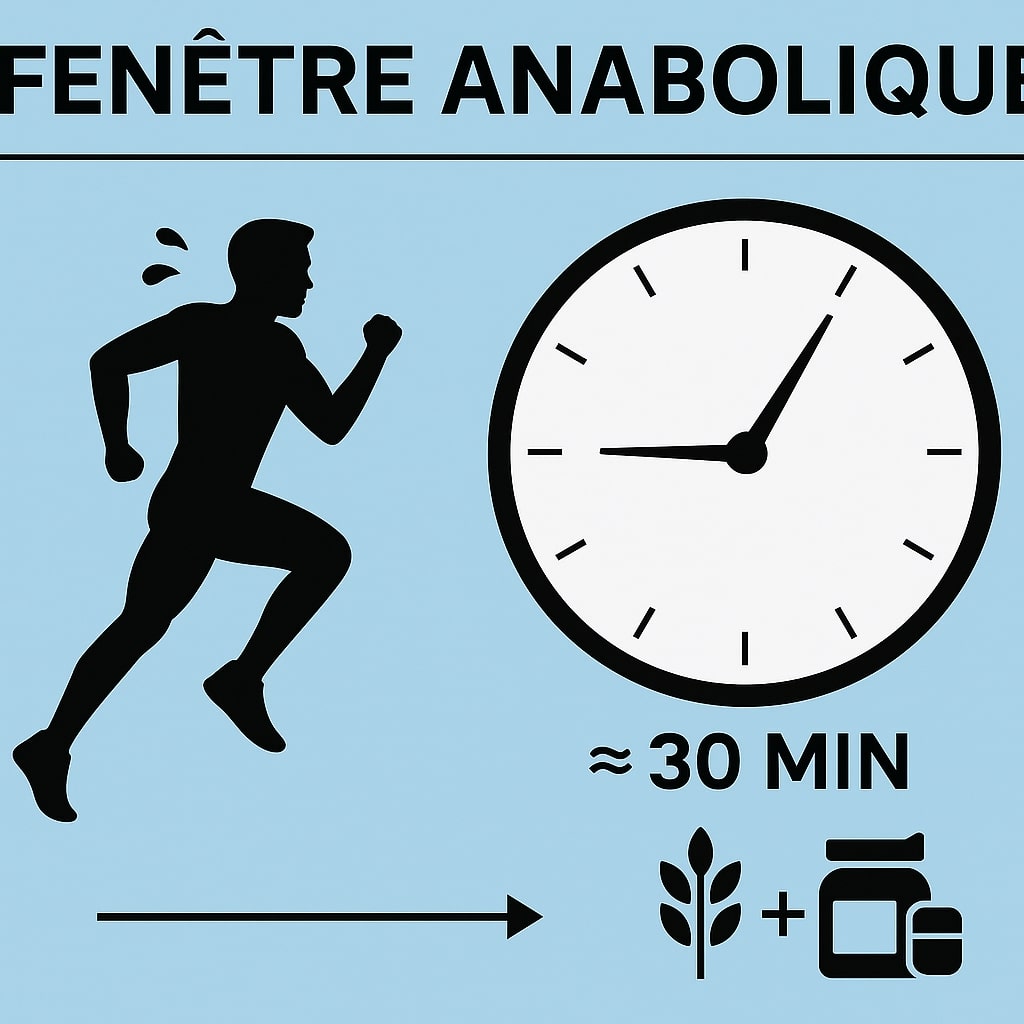Sign up for our newsletter and get 10% off!
The Anabolic Window in Sports: Everything You Need to Know

Gautier Lalevée

What Is the Anabolic Window?
The Anabolic Window in Sports: Everything You Need to Know
The anabolic window is a key concept in sports nutrition. It refers to the post-workout period during which the body is particularly receptive to nutrients that support recovery and muscle growth.
In this article, we’ll explain what the anabolic window is, how to make the most of it, which nutrients to focus on, and how factors like age, type of sport, and overall diet can influence its effectiveness.
What Is the Anabolic Window?
The anabolic window refers to the minutes and hours following an intense workout, especially strength or endurance training. After exercise, glycogen stores are depleted, muscle fibers are damaged, and the body enters a catabolic (tissue breakdown) state.
During this time, the body is more sensitive to insulin, a hormone that helps transport nutrients into muscle cells. This increased sensitivity allows for better muscle protein synthesis and faster glycogen replenishment.
However, the exact duration of this window is still debated among scientists and sports nutrition experts.
The Classic Theory: A Short Window (30 to 60 Minutes)
For many years, it was believed that this window lasted only 30 to 60 minutes after training. The idea was that following intense exercise, the body experiences significant muscle breakdown and glycogen depletion — and that consuming protein and carbohydrates quickly was critical to avoid muscle loss and maximize protein synthesis.
A Broader Perspective: Up to 24 Hours
More recent studies suggest that the anabolic window may actually be much longer than previously thought.
In reality:
-
Insulin sensitivity, which aids nutrient absorption and muscle repair, remains elevated for several hours post-exercise.
-
Muscle protein synthesis is enhanced for up to 24 to 48 hours after a workout, although the effect is strongest in the first few hours.
-
What matters most is the total protein intake across the day, rather than just the immediate post-workout meal.
The Importance of Overall Nutrition
If your daily diet is already rich in high-quality protein and well-balanced, the anabolic window becomes less critical.
That said, proper post-workout nutrition still plays an important role in optimizing recovery and overall performance.
How to Optimize the Anabolic Window?
Timing
Even though the anabolic window doesn’t close immediately after a workout, it’s still recommended to consume nutrients at specific intervals:
-
Within 30 to 60 minutes: a fast-digesting protein source (whey, BCAAs) and quick carbohydrates (maltodextrin, fruits) to kickstart recovery.
-
Within the next 2–6 hours: a balanced meal with complete proteins, complex carbohydrates, and healthy fats.
-
Throughout the day: maintain a regular intake of protein to support ongoing muscle repair and rebuilding.
What Nutrients to Consume?
The athlete’s goal is to provide the body with quickly available proteins and carbohydrates to support recovery:
-
Proteins (1.2 to 2.5 g/kg): support muscle repair and stimulate protein synthesis.
Examples: Whey protein, lean meats, fish, eggs, Greek yogurt, legumes. -
Carbohydrates (4 to 12 g/kg): replenish muscle glycogen stores.
Examples: Oats, fruits, honey, sweet potatoes, rice, powdered dextrose/maltodextrin. -
Fats: Slow down nutrient absorption. Should be consumed in moderation right after training.
-
Hydration: Water and electrolytes (sodium, potassium, magnesium) are essential for recovery.
Factors That Influence the Anabolic Window
Age
-
As we age, muscle protein synthesis becomes less efficient (reduced anabolism).
-
It may be necessary to increase protein intake to compensate.
Type of Sport and Training Volume
-
Strength Training: The anabolic window is especially important, as resistance training causes micro-tears in the muscles that require rapid repair.
-
Endurance Sports (running, cycling, swimming): The main focus is glycogen replenishment rather than protein synthesis.
-
Mixed Sports (rugby, CrossFit, football): A balanced intake of both proteins and carbohydrates is essential.
Recovery3 and the Anabolic Window: A Key to Effective Recovery
Recovery3 is a formulation designed to optimize post-workout recovery, performance, and therefore support the anabolic window. Thanks to its content of proteins, carbohydrates, minerals, and antioxidants, it effectively supports recovery and the maintenance of muscle mass, helps reduce fatigue, and contributes to protecting cells from the effects of oxidative stress. Its convenient, portable sachet format allows it to be consumed immediately after exercise, whether you are at home or on the go. It is an ideal ally for athletes looking to maximize their performance and recovery.
Sources :
Ivy, J. L. (2004). “Nutrition and exercise performance: an overview.” Sports Science Exchange, 17(3), 1-8.
Phillips, S. M., & Van Loon, L. J. (2011). “Dietary protein for athletes: From requirements to metabolic advantage.” Applied Physiology, Nutrition, and Metabolism, 36(6), 647-660.
Schoenfeld, B. J., & Aragon, A. A. (2018). “How much protein can the body use in a single meal for muscle-building? Implications for daily protein distribution.” Journal of the International Society of Sports Nutrition, 15(1), 10.
Ratamess, N. A. (2012). “Effect of nutrition on muscle mass, strength, and endurance.” In Nutrition and Enhanced Sports Performance (pp. 184-199). Academic Press.
Tarnopolsky, M. A. (2004). “Protein supplements and exercise.” Canadian Journal of Applied Physiology, 29(3), 266-299.
Ivy, J. L., & Ferguson-Stegall, L. (2013). “Nutrient Timing: The Means to Improved Exercise Performance, Recovery, and Training Adaptation.” American Journal of Lifestyle Medicine, 7(4), 246–258. DOI:10.1177/1559827613480083
Aragon, A. A., & Schoenfeld, B. J. (2013). “Nutrient timing revisited: is there a post-exercise anabolic window?” Journal of the International Society of Sports Nutrition, 10(5). DOI:10.1186/1550-2783-10-5
Macnaughton, L. S., et al. (2016). “The response of muscle protein synthesis following whole-body resistance exercise is greater following 40 g than 20 g of ingested whey protein.” Physiological Reports, 4(15), e12893. DOI:10.14814/phy2.12893
Tipton, K. D., et al. (2001). “Timing of amino acid-carbohydrate ingestion alters anabolic response of muscle to resistance exercise.” American Journal of Physiology-Endocrinology and Metabolism, 281(2), E197-E206. DOI:10.1152/ajpendo.2001.281.2.E197


